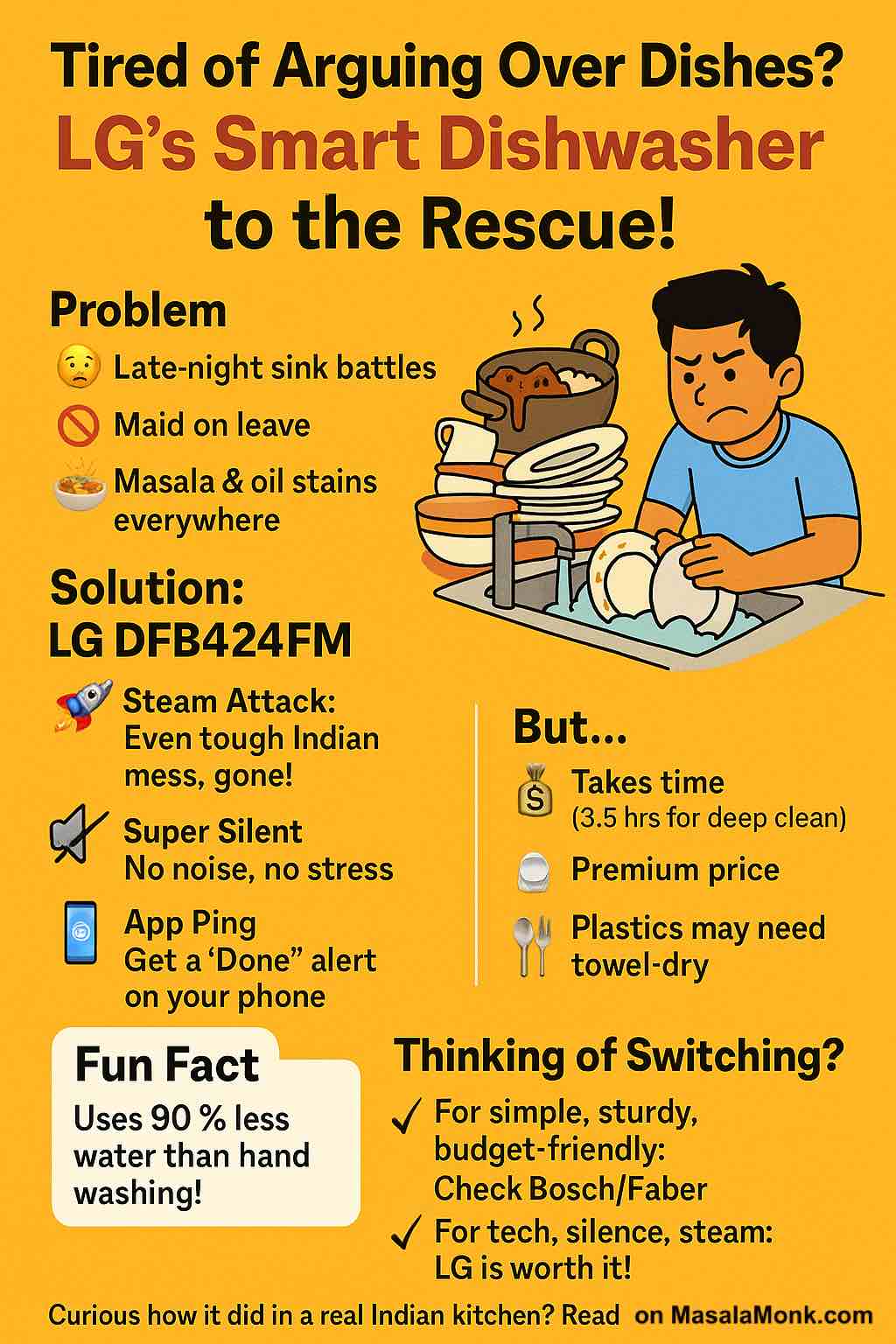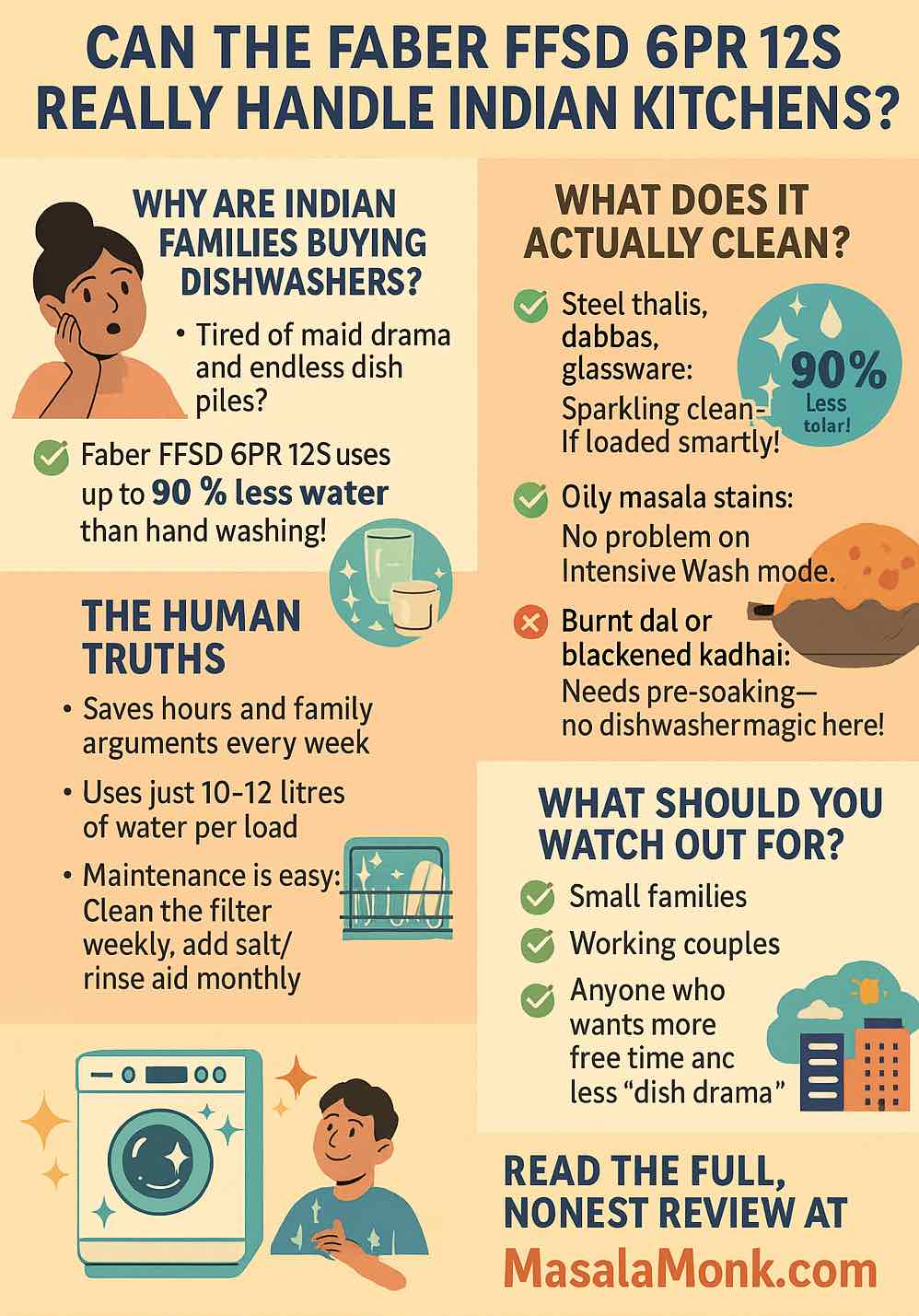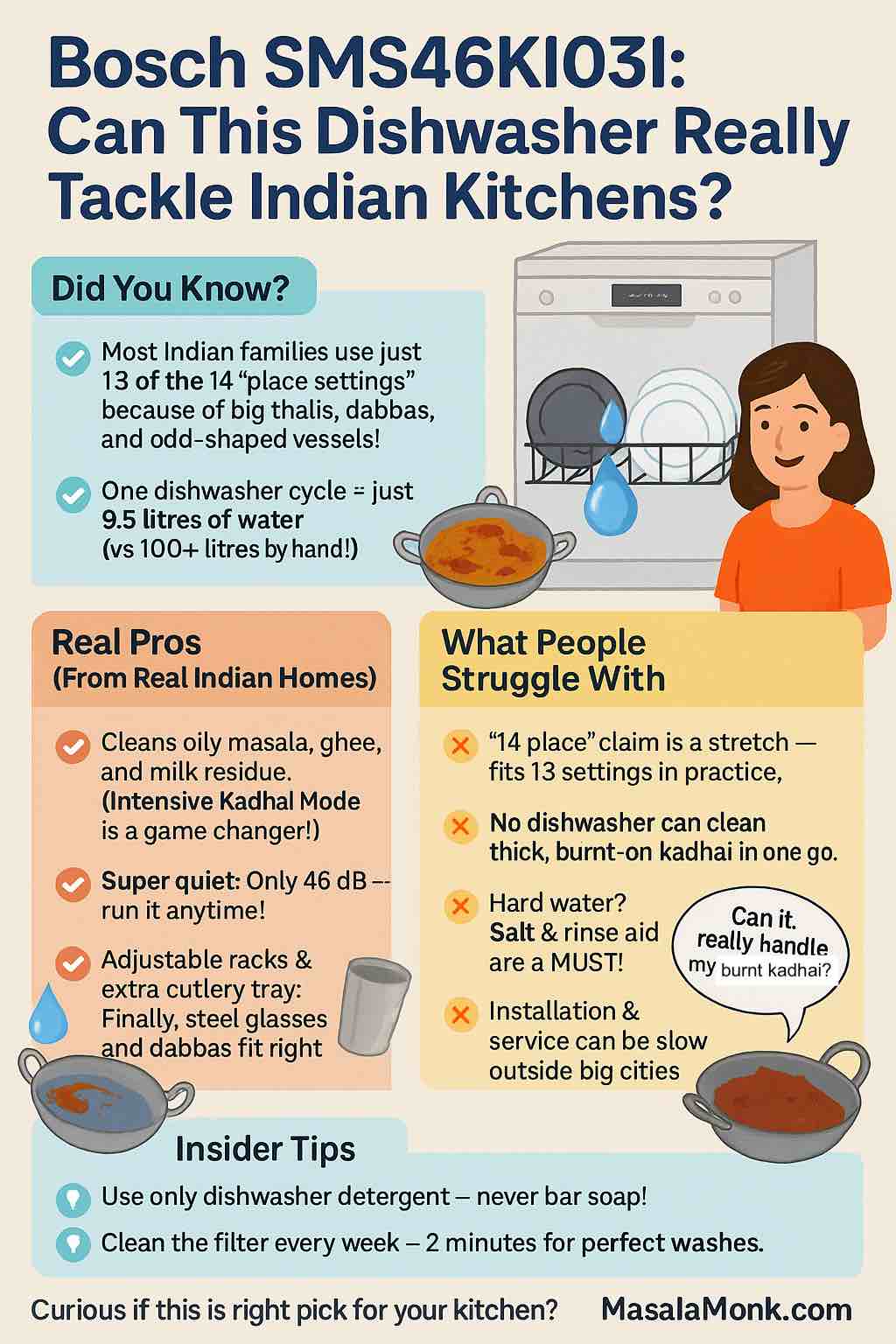
Is It the Best Choice for Indian Families—Or Just Expensive Hype?
Ever felt like your kitchen is stuck in a daily episode of “Dish Drama?”
Maids disappear, everyone ducks after dinner, and you’re left facing a battlefield of oily thalis, sticky kadhais, and burnt milk pans.
If you’re even thinking about a dishwasher, you’re already ahead of the curve. And you’re not alone. Dishwashers are flying off the (virtual) shelves in India, but which one is right for you? Today, we go deep into the LG DFB424FM 14-Place Dishwasher (see on Amazon), comparing it side-by-side with Bosch and Faber bestsellers.
This is not a copy-paste from the spec sheet. This is your neighbor’s honest feedback, your cousin’s kitchen experiment, and the stuff nobody tells you until you’ve done 20 loads yourself.
Meet the LG DFB424FM:
The High-Tech, Low-Drama Dishwasher?
- 14 Place Settings:
Handles a full day’s worth of Indian family meals—thalis, dabbas, kadhais, and glasses. Big enough for 5–7 people or those who batch cook. - TrueSteam™:
Shoots high-temperature steam into every cycle. Great for dissolving masala, ghee, and sticky chai stains. - QuadWash™:
Four spray arms shoot water in all directions—no more “missed” spots or uncle’s curry bowl hiding at the back. - EasyRack™ Plus:
Adjustable racks. Raise, lower, or split to fit tall tumblers, pressure cookers, and everything in between. - Wi-Fi & LG ThinQ App:
Start your wash remotely, get notifications, download new wash cycles—if you’re into smart home tech, it’s a treat. - Inverter Direct Drive Motor:
Reliable, silent, with a 10-year warranty. - Noise:
Just 44 dB—so quiet you’ll wonder if it’s on. - Water Use:
Only ~9–10L per cycle. - Matte Black, Sleek Build:
Looks premium, resists fingerprints.
What Real Indian Users Love
1. The Cleaning is Actually Impressive
- TrueSteam makes a visible difference—oily mess, masala crust, and “last night’s dal” all get sorted.
- QuadWash is a genuine upgrade: “My plates, bowls, and even kadhais come out clean—corners too!” (user review)
2. Flexible Loading Is a Lifesaver
- Those who learned “dishwasher Tetris” on old machines will appreciate EasyRack Plus.
- You can finally fit tall bottles, awkward pressure cookers, and lots of thalis—no more playing musical chairs with utensils.
3. Peace & Quiet (Really)
- At 44 dB, it’s so silent that users check if it’s running.
- Perfect for open kitchens or late-night cycles.
4. Modern Features for Modern Kitchens
- Wi-Fi & App control isn’t just a gimmick: you can start the dishwasher from the office, get a ping when it’s done, or diagnose issues without waiting for a technician.
5. Excellent Drying (for Steel & Glass)
- TrueSteam plus Auto Open Dry means fewer water spots.
- Users say steel and glass come out sparkling—plastics, like all dishwashers, may need a quick wipe.
What Might Annoy You
1. Price Tag
- This is a premium product—costs more than Faber and mid-range Bosch.
- But if you want quiet, tech, and great drying, you get what you pay for.
2. Long Cycles
- Standard wash: ~3.5 hours.
Turbo and Quick Wash modes are faster, but may not handle the dirtiest loads. - If you’re always in a hurry, be prepared to plan ahead or run smaller loads.
3. Spare Parts & Service Can Be Patchy
- Metro city? No problem. Smaller town? Some users waited for parts or repairs—check your local LG service first.
4. Overwhelming Tech for Some
- If you don’t want to deal with Wi-Fi, apps, and downloads, the features might feel like too much.
Troubleshooting & Indian Kitchen Challenges
| Challenge | Solution/Workaround |
|---|---|
| Burnt/baked-on mess | Pre-soak tough kadhais, scrape solids before loading |
| Plastics don’t always dry | Use the top rack and open the door after cycle; quick towel swipe for stubborn water |
| Racks overloaded or misaligned | Take time to adjust racks for your vessel shapes; don’t block spray arms |
| Cycle too long? | Use Turbo or Quick for lightly soiled loads, but stick to full cycles for masala |
| Wi-Fi not working | Most settings work via physical buttons if you want to skip the app |
Real User Feedback: The Good, the Bad, and the “Wish I Knew This”
- “Quietest dishwasher I’ve ever owned. Cleans everything, even my pressure cooker lids. I actually enjoy loading it!”
- “Standard cycle is long, but it’s worth it for how spotless everything is.”
- “Service in my city (Hyderabad) was great, but my cousin in a tier-3 town waited a week for a technician.”
- “Wi-Fi setup was tricky, but I love getting a phone ping when it’s done.”
- “Turbo wash is too short for oily loads—go with Auto or Eco instead.”
⭐ What Makes This LG Dishwasher Stand Out?
- Steam Cleaning for Indian Grease:
TrueSteam’s hot vapour is highly effective on masala, ghee, and sticky Indian messes—less scrubbing needed. - Best-in-Class Drying:
Steam + Auto Open Dry delivers drier dishes, fewer spots (especially on glassware and steel). - Super Silent:
At 44 dB, it’s among the quietest dishwashers on the Indian market. - Flexible Loading:
The EasyRack Plus system genuinely helps fit odd utensils (big tiffins, thalis, pans)—reducing the “won’t fit” frustration. - Smart App Control:
Great for tech-savvy families—remote start, status checks, and troubleshooting are easy with LG ThinQ.
👩🍳 Initial User Impressions (from Amazon, LG site, and Indian forums)
Pros:
- “Cleans very well even on heavily soiled Indian utensils—especially with TrueSteam and QuadWash.”
- “Extremely quiet—even with heavy loads.”
- “Easy to adjust racks for large plates and bowls. Handles thalis and kadhais.”
- “App notifications are actually useful if you tend to forget loads.”
Cons:
- “Price is higher than Bosch/Faber, but features feel premium.”
- “Initial setup can be confusing due to the app and rack adjustments. Watching the demo video really helps.”
- “Spare parts/service in smaller towns may not be as fast as in metros.”
📝 Should You Consider This Over Bosch/Faber?
LG DFB424FM (see on Amazon) is aimed at families who:
- Want ultra-quiet operation and top-tier cleaning/drying (thanks to TrueSteam & QuadWash)
- Like smart-home features and remote app control
- Regularly load large, mixed utensils and want more flexibility than traditional racks
- Are okay paying a premium for those extras
Bosch models still win on widespread service, slightly lower price, and “set & forget” operation without tech, but LG is a genuine contender if you want something modern and flexible.
How Does LG DFB424FM Compare to Bosch & Faber?
LG DFB424FM (Amazon)
- Best for:
- Large families, modern kitchens, tech lovers, and those who need ultra-quiet operation.
- Shines at:
- Drying, steam cleaning, rack flexibility, and smart home features.
- Downsides:
- Premium price, long cycle times, advanced features may be wasted if you’re “old-school”.
Bosch SMS66GW01I / SMS66GI01I (White / Silver)
See our detailed review: Bosch 13-Place Review
- Best for:
- Medium to large Indian families, value-conscious buyers.
- Shines at:
- Intensive Kadhai program for masala/oily loads, strong build, reliable support.
- Downsides:
- Not as quiet or flexible as LG; fewer “smart” features.
Bosch SMS46KI03I (Amazon)
Full review: Bosch 14-Place Review
- Best for:
- Large, busy families, joint homes, or those wanting extra capacity and premium racks.
- Shines at:
- Flexibility (3-stage racks), very quiet operation, and top build quality.
- Downsides:
- Higher price, but justified for bigger, busier kitchens.
Faber FFSD 6PR 12S (Amazon)
Read our honest take: Faber Dishwasher Review
- Best for:
- Small families, first-time buyers, or those on a budget.
- Shines at:
- Solid cleaning, good value, easy to use.
- Downsides:
- Feels less premium, racks fill fast, and drying is only “good enough”.
LG DFB424FM vs Bosch (13/14-Place) vs Faber (12-Place):
Which Dishwasher Really Suits the Modern Indian Kitchen?
| Feature | LG DFB424FM 14-Place – Buy | Bosch SMS66GW01I/ SMS66GI01I 13-Place – White / Silver – Review | Bosch SMS46KI03I 14-Place –Buy – Review | Faber FFSD 6PR 12S 12-Place –Buy |
|---|---|---|---|---|
| Capacity | 14-place (genuine, big thalis fit well) | 13-place (good for families, fits most utensils with care) | 14-place (excellent for joint families and heavy use) | 12-place (best for small families, tight for big vessels) |
| Key Cleaning Tech | TrueSteam + QuadWash, high-temp steam & multi-arm spray | Intensive Kadhai program (excellent for masala/oil) | Intensive Kadhai, extra drying features, 3-stage racks | Intensive wash, standard sprays |
| Drying Performance | TrueSteam & Auto Open Dry = almost spotless, very few water marks | Good, may need towel for deep bowls/plastic | Best-in-class, advanced heat exchanger drying | Good, but some water spots on plastic/bowls |
| Noise Level | 44 dB (ultra-quiet, best in class) | 52 dB (quiet for most flats, but not the quietest) | 46 dB (very quiet, easy to run at night) | 49 dB (acceptable, but audible at night) |
| Flexibility | EasyRack Plus: fully adjustable racks, Wi-Fi/app control, app cycles | Good racks, less flexible than LG/Bosch 14, classic dials/buttons | 3-stage racks, extra cutlery drawer, best flexibility | Basic racks, can be cramped with large loads |
| Build Quality | Premium (stainless inside & out, strong motor, matte black finish) | Robust, all-steel interior, built to last | Highest premium feel, max steel, anti-fingerprint | More plastic parts, feels less premium |
| Water/Energy Use | ~9–10L per wash, A++ rating | ~9.5L per wash, A++ rating | ~9.5L per wash, A++ rating | 10–12L per wash, A++ rating |
| Tech & Smart Features | Wi-Fi, ThinQ app, remote start, smart diagnosis, cycle downloads | None—classic interface, reliable & simple | None (physical buttons, LED display, reliable) | None—physical buttons only |
| Service/Support | Good in metros, slower in small towns; app helps with troubleshooting | Best service network, fast install, good long-term support | Same as Bosch 13-place, plus longer rust warranty | Good in metros, can be slow elsewhere |
| Cycle Duration | Standard: 3.5 hrs (deep cleaning), Turbo/Quick = shorter but not as effective | 2.5–3 hrs for normal; Quick & Intensive programs available | Similar, with faster Intensive options | 2–3.5 hrs, fast wash is available |
| Price Segment | Premium (highest price, but advanced features) | Mid-range (strong value, reliable, Indian-kitchen proven) | Premium (highest among Bosch, top features) | Budget (most affordable among these) |
The Verdict: Is LG’s Dishwasher Right For You?
If you:
- Want peace, quiet, and spotless utensils without endless arguments…
- Love tech, apps, or have a big, modern kitchen…
- Don’t mind a higher upfront price for premium performance and flexibility…
…the LG DFB424FM (check on Amazon) will make you wonder why you waited so long.
But if you want maximum value, simple controls, or have a smaller family, Bosch or Faber are still absolute workhorses for Indian kitchens.
Tips for Dishwasher Success in India
- Pre-soak burnt or baked-on dishes, whatever the brand.
- Stack smart—don’t block spray arms, and use adjustable racks.
- Keep salt and rinse aid topped up, especially in hard water cities.
- Clean the filter weekly (it matters!).
- For plastics, just towel dry if needed—no machine is perfect here.
Read More Before You Buy
Got a question, horror story, or success hack? Drop it in the comments—real families help each other!
Affiliate Disclosure:
This post uses affiliate links (like this one for the LG DFB424FM). If you buy, I may earn a small commission—at no extra cost to you. It helps keep these reviews honest, practical, and always for Indian families.
Share this with your favorite WhatsApp group—maybe you’ll finally win the “who does the dishes” debate!
FAQs: LG DFB424FM 14-Place Dishwasher (Indian Family Perspective)
1. Is the LG DFB424FM dishwasher suitable for Indian utensils like thalis, kadhais, and pressure cookers?
Yes! The adjustable EasyRack Plus system lets you fit large thalis, dabba, kadhais, and tall utensils. You may need to experiment a bit to get the best layout, especially for oddly shaped vessels.
2. How well does it handle oily, masala-heavy Indian mess?
The TrueSteam and QuadWash features are designed for tough stains—oily, masala-heavy plates, and even kadhai come out clean if you use the Intensive or Auto cycles. For burnt-on food, pre-soak is still recommended.
3. Does it dry utensils completely?
It delivers excellent drying for steel and glassware, thanks to TrueSteam and Auto Open Dry. Plastics may still need a quick towel dry, which is common with all brands.
4. Is it really quiet? Can I run it at night?
Yes, it’s among the quietest dishwashers available at just 44 dB. Most users find it virtually silent and perfect for night cycles.
5. How much water and electricity does it use per wash?
It uses around 9–10 litres of water per cycle (far less than handwashing), and is energy efficient (A++), so electricity bills won’t spike.
6. How reliable is LG’s after-sales service?
Service is generally good in metros and tier-1 cities. In smaller towns, some users reported delays in getting repairs or spare parts. Always check local service reviews before buying.
7. Is the Wi-Fi/App feature actually useful or just a gimmick?
If you like tech, you’ll enjoy remote starts, cycle notifications, and Smart Diagnosis through the LG ThinQ app. If not, you can ignore it and use the manual buttons instead.
8. Are there any major drawbacks for Indian users?
The main complaints are long standard cycle times (up to 3.5 hours), a premium price, and that some tech features may go unused. Also, as with all dishwashers, plastics may need a towel after drying.
9. How does this compare to Bosch and Faber dishwashers?
LG wins on quietness, drying, rack flexibility, and tech features. Bosch is more proven in Indian kitchens and may have better service and simpler controls. Faber is the budget-friendly pick for small families.
10. Who should buy the LG DFB424FM—and who should skip it?
Buy it if you want top-tier performance, silent operation, and love tech. Consider Bosch or Faber if you want maximum value, a simpler interface, or live in an area with better non-LG service.











